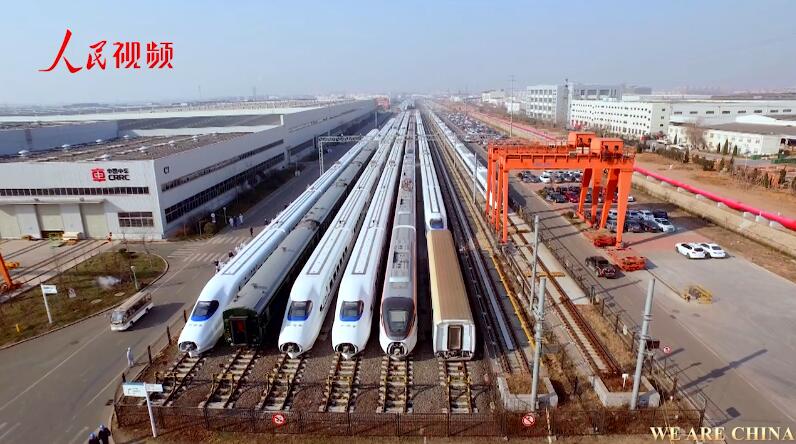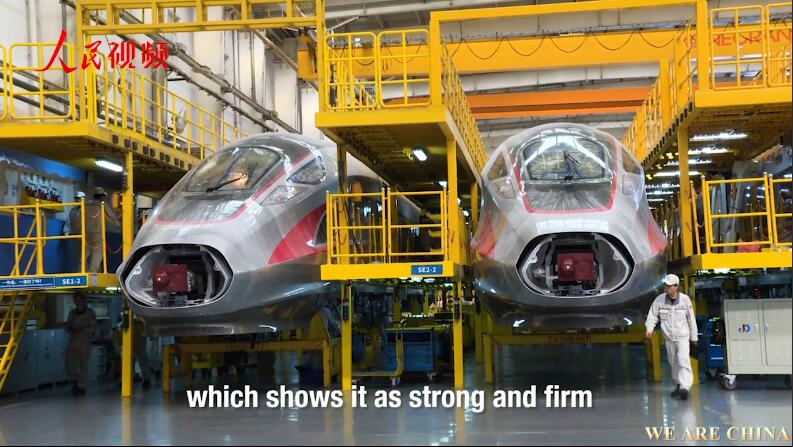

This is where half of China's high-speed bullet trains were assembled, in east China's coastal city, Qingdao, which will also host the 18th summit of the Shanghai Cooperation Organization this year.

A huge production base of high-speed electric multiple unit (EMU) trains, CRRC Qingdao Sifang Co., Ltd. covers an area of 1.77 million square meters, equivalent to the size of 248 standard soccer fields. The very first "Fuxing" bullet train was born here. The EMU can maintain a constant speed of 350 kilometers an hour, with China holding the complete intellectual property rights of these new bullet trains.
"We adopted the design of a Dragon Totem for the train's head, which shows it as strong and firm," said Yan Guizhen, senior chief designer for CRRC Sifang, "We made sure the whole train is smooth in shape with no protruding objects of any kind in order to guarantee low resistance when it's running."

"We used to just be competing our way through a global market," said Yang Jianxue, director of overseas marketing for CRRC Sifang, "As Chinese government put more focus on the Belt and Road Initiative, railway transportation and high-speed bullet train technologies, we turned competition into cooperation in many countries."
For example, Japan, which used to be China's competitor, now works with CRRC as a third-party partner in some international railway projects in Southeast Asia.
"In addition, the construction of high-speed railway lines in Southeast Asia, such as the Jakarta-Bandung high-speed railway project, the China-Laos railway project and the China-Thailand railway project has provided us with plenty of opportunities," Yang said.
CRRC Sifang has exported railway technologies to over 20 countries and regions across the world, including the U.S., Argentina and Sri-Lanka. Expect to see more of China's railway technologies running on a global stage in the future.

 Award-winning photos show poverty reduction achievements in NE China's Jilin province
Award-winning photos show poverty reduction achievements in NE China's Jilin province People dance to greet advent of New Year in Ameiqituo Town, Guizhou
People dance to greet advent of New Year in Ameiqituo Town, Guizhou Fire brigade in Shanghai holds group wedding
Fire brigade in Shanghai holds group wedding Tourists enjoy ice sculptures in Datan Town, north China
Tourists enjoy ice sculptures in Datan Town, north China Sunset scenery of Dayan Pagoda in Xi'an
Sunset scenery of Dayan Pagoda in Xi'an Tourists have fun at scenic spot in Nanlong Town, NW China
Tourists have fun at scenic spot in Nanlong Town, NW China Harbin attracts tourists by making best use of ice in winter
Harbin attracts tourists by making best use of ice in winter In pics: FIS Alpine Ski Women's World Cup Slalom
In pics: FIS Alpine Ski Women's World Cup Slalom Black-necked cranes rest at reservoir in Lhunzhub County, Lhasa
Black-necked cranes rest at reservoir in Lhunzhub County, Lhasa China's FAST telescope will be available to foreign scientists in April
China's FAST telescope will be available to foreign scientists in April